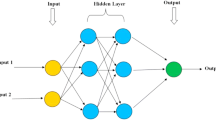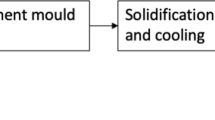Abstract
The paper presents some results of the research connected with the development of new approach based on the fuzzy logic of predicting the Vickers microhardness of the phase constituents occurring in five steels after continuous cooling. The independent variables in the model are chemical compositions, initial austenite grain size, and cooling rate over the temperature range of the occurrence of phase transformations. For purpose of constructing these models, 114 different experimental data were gathered from the literature. The data used in the fuzzy logic model are arranged in a format of twelve input parameters that cover the chemical compositions, initial austenite grain size, and cooling rate, and output parameter which is Vickers microhardness. In this model, the training and testing results in the fuzzy logic systems have shown strong potential for prediction of effects of chemical compositions and heat treatments on hardness of microalloyed steels.




Similar content being viewed by others
Change history
19 January 2021
A Correction to this paper has been published: https://doi.org/10.1007/s00521-020-05577-0
References
Ohya K, Kim J, Yokohama K, Nagumo M (1996) Microstructures relevant to brittle fracture initiation at the heat-affected zone of weldment of a low carbon steel. Metall Mater Trans A 27A:2574
Li Y, Crowther D, Green M, Mitchell P, Baker T (2001) The effect of vanadium and niobium on the properties and microstructure of the intercritically reheated coarse grained heat affected zone in low carbon microalloyed steels. ISIJ Int 41:46
El-Kashif E, Koseki T (2007) Effect of niobium on HAZ microstructure and toughness of HSLA steels. Mater Sci Forum 539–43:4838–4843
Bhadeshia HKDH (1999) Neural networks in materials science. ISIJ Int 39:966–979
Nazari A, Milani AA, Zakeri M (2011) Modeling ductile to brittle transition temperature of functionally graded steels by artificial neural networks. Comput Mater Sci 50:2028–2037
Trzaska J, Jagiello A, Dobrzanski LA (2009) The calculation of CCT diagrams for engineering steels. Arch Mater Sci Eng 39:13–20
Tugrul O, Yigit K (2005) Predictive modeling of surface roughness and tool wear in hard turning using regression and neural networks. Int J Mach Tools Manuf 45:467–479
Fredj NB, Amamou R (2006) Ground surface roughness prediction based upon experimental design and neural network models. Int J Adv Manuf Technol 31:24–36
Brahme A, Winning M, Raabe D (2009) Prediction of cold rolling textures of steels using an artificial neural network. Comput Mater Sci 46:800–804
Hwang R, Chen Y, Huang H (2010) Artificial intelligent analyzer for mechanical properties of rolled steel bar by using neural networks. Expert Syst Appl 37:3136–3139
Pujol JCF, Pinto JMA (2011) A neural network approach to fatigue life prediction. Int J Fatigue 33:313–322
Singh SK, Mahesh K, Gupta AK (2010) Prediction of mechanical properties of extra deep drawn steel in blue brittle region using artificial neural network. Mater Des 31:2288–2295
Khalaj G, Yoozbashizadeh H, Khodabandeh A, Nazari A (2011) Artificial neural network to predict the effect of heat treatments on Vickers microhardness of low-carbon Nb microalloyed steels. Neural Comput Appl. doi:10.1007/s00521-011-0779-z
Trzaska J, Dobrzanski LA (2005) Application of neural networks for designing the chemical composition of steel with the assumed hardness after cooling from the austenitising temperature. J Mater Process Technol 164–165:1637–1643
Monajati H, Asefi D, Parsapour A, Abbasi S (2010) Analysis of the effects of processing parameters on mechanical properties and formability of cold rolled low carbon steel sheets using neural networks. Comput Mater Sci 49:876–881
Parthiban T, Ravi R, Parthiban GT, Srinivasan S, Ramakrishnan KR, Raghavan M (2005) Neural network analysis for corrosion of steel in concrete. Corros Sci 47:1625–1642
Rolich T, Rezic I, Curkovic L (2010) Estimation of steel guitar strings corrosion by artificial neural network. Corros Sci 52:996–1002
Mukherjee M, Singh SB (2009) Artificial neural network: some applications in physical metallurgy of steels. Mater Manuf Process 24:198–208
Bhadeshia HKDH, Dimitriu RC, Forsik S, Pak JH, Ryu JH (2009) On the performance of neural networks in materials science. Mater Sci Technol 25:504–510
Nazari A, Didehvar N (2011) Analytical investigations and fuzzy logic-based modeling of the impact resistance of aluminum-epoxy laminated composites. doi:10.1007/s11431-011-4531-9
Nazari A, Milani AA (2011) Modeling ductile to brittle transition temperature of functionally graded steels by fuzzy logic. J Mater Sci 46(18):6007–6017. doi:10.1007/s10853-011-5563-z
Park Y, Cho H (2005) A fuzzy logic controller for the molten steel level control of strip casting processes. Control Eng Pract 13(7):821–834
Ünal O, Demir F, Uygunoğlu T (2007) Fuzzy logic approach to predict stress–strain curves of steel fiber-reinforced concretes in compression. Build Environ 42(10):3589–3595
Kor M, Abkhoshk E, Tao D, Chen GL, Modarres H (2010) Modeling and optimization of high chromium alloy wear in phosphate laboratory grinding mill with fuzzy logic and particle swarm optimization technique. Miner Eng 23(9):713–719
Akkurt S, Tayfur G, Can S (2004) Fuzzy logic model for the prediction of cement compressive strength. Cem Concr Res 34(8):1429–1433
Demir F (2005) A new way of prediction elastic modulus of normal and high strength concrete-fuzzy logic. Cem Concr Res 35(8):1531–1538
Sen Z (1998) Fuzzy algorithm for estimation of solar irradiation from sunshine duration. Sol Energy 63(1):39–49
Passino KM, Yurkovich S (1998) Fuzzy control. Addison-Wesley, Reading, MA
Ho DWC, Zhang PA, Xu J (2001) Fuzzy wavelet networks for function learning. IEEE Trans Fuzzy Syst 9(1):200–211
McNeill FM, Thro E (1994) Fuzzy logic: a partial approach. AP Professional, Boston, MA
Takagi T, Sugeno M (1985) Fuzzy identification of systems and its applications to modeling and control. IEEE Trans Syst Man Cybern 15:116–132
Jang JSR, Sun CT (1995) Neuro-fuzzy modeling and control. In: Proceeding of the IEEE 83(3):378–405
Akbulut S, Hasiloglu AS, Pamukcu S (2004) Data generation for shear modulus and damping ratio in reinforced sands using adaptive neuro-fuzzy inference system. Soil Dyn Earthq Eng 24(11):805–814
Topcu IB, Sarıdemir M (2008) Prediction of mechanical properties of recycled aggregate concretes containing silica fume using artificial neural networks and fuzzy logic. Comput Mater Sci 41(1):74–82
Topcu IB, Sarıdemir M (2008) Prediction of rubberized concrete properties using artificial neural network and fuzzy logic. Constr Build Mater 22(4):532–540
Gerami S (2010) Characterization and microstructural evolution model of a Nb complex phase steel. Master’s thesis, The University of British Columbia
Tafteh R (2011) Austenite decomposition in an X80 linepipe steel. Master’s thesis, The University of British Columbia
Lottey KK (2002) Austenite decomposition of a HSLA-Nb,Ti steel and an A1-TRIP steel during continuous cooling. Master’s thesis, The University of British Columbia
Olasolo M, Uranga P, Rodriguez-Ibabe JM, López B (2011) Effect of austenite microstructure and cooling rate on transformation characteristics in a low carbon Nb–V microalloyed steel. Mater Sci Eng A 528:2559–2569
Petkovi P (2004) Austenite decomposition of low carbon high strength steels during continuous cooling. Master’s thesis, The University of British Columbia
Sarkar S (2008) Microstructural evolution model for hot strip rolling of a Nb-Mo complex-phase steel. PhD thesis, UBC
Topcu IB, Sarıdemir M (2008) Prediction of compressive strength of concrete containing fly ash using artificial neural network and fuzzy logic. Comput Mater Sci 41(3):305–311
Author information
Authors and Affiliations
Corresponding author
About this article
Cite this article
Khalaj, G., Yoozbashizadeh, H., Khodabandeh, A. et al. RETRACTED ARTICLE: Modeling hardness of Nb-microalloyed steels using fuzzy logic. Neural Comput & Applic 23, 207–214 (2013). https://doi.org/10.1007/s00521-011-0802-4
Received:
Accepted:
Published:
Issue Date:
DOI: https://doi.org/10.1007/s00521-011-0802-4




